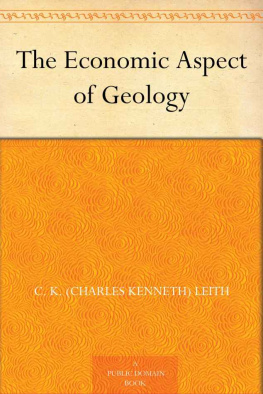| CHAPTER | PAGE |
| INTRODUCTION | 1 |
| Survey of Field |
| Economic applications of the several branches of geology and of other sciences |
| Mineralogy and petrology |
| Stratigraphy and paleontology |
| Structural geology |
| Physiography |
| Rock alterations or metamorphism |
| Application of other sciences |
| Treatment of the subject in this volume |
| THE COMMON ELEMENTS, MINERALS, AND ROCKS OF THE EARTH AND THEIR ORIGINS | 13 |
| Relative abundance of the principal elements of the lithosphere |
| Relative abundance of the principal minerals of the lithosphere |
| Relative abundance of the principal rocks of the lithosphere |
| Water (hydrosphere) |
| Soils and clays |
| Comparison of lists of most abundant rocks and minerals with commercial rocks and minerals |
| The origin of common rocks and minerals |
| Igneous processes |
| Igneous after-effects |
| Weathering of igneous rocks and veins |
| Sedimentary processes |
| Weathering of sedimentary rocks |
| Consolidation, cementation, and other sub-surface alterations of rocks |
| Cementation |
| Dynamic and contact metamorphism |
| The metamorphic cycle as an aid in studying mineral deposits |
| SOME SALIENT FEATURES OF THE GEOLOGY AND CLASSIFICATION OF MINERAL DEPOSITS | 29 |
| Various methods of classification |
| Names |
| Mineral deposits as magmatic segregations in igneous rocks |
| Mineral deposits within and adjacent to igneous rocks, which were formed immediately after the cooling and crystallization of the magmas through the agency of hot magmatic solutions |
| Evidence of igneous source |
| Possible influence of meteoric waters in deposition of ores of this class |
| Zonal arrangement of minerals related to igneous rocks |
| The relation of contact metamorphism to ore bodies of the foregoing class |
| Secondary concentration in place of the foregoing classes of mineral deposits through the agency of surface solutions |
| Residual mineral deposits formed by the weathering of igneous rocks in place |
| Mineral deposits formed directly as placers and sediments |
| Mechanically deposited minerals |
| Chemically and organically deposited minerals |
| Sedimentary mineral deposits which have required further concentration to make them commercially available |
| Anamorphism of mineral deposits |
| Conclusion |
| MINERAL RESOURCESSOME GENERAL QUANTITATIVE CONSIDERATIONS | 60 |
| World annual production of minerals in short tons |
| World annual production of minerals in terms of value |
| Significance of geographic distribution of mineral production |
| The increasing rate of production |
| Capital value of world mineral reserves |
| Political and commercial control of mineral resources |
| Reserves of mineral resources |
| WATER AS A MINERAL RESOURCE | 67 |
| General geologic relations |
| Distribution of underground water |
| Movement of underground water |
| Wells and springs |
| Composition of underground waters |
| Relation of geology to underground water supply |
| Surface water supplies |
| Underground and surface waters in relation to excavation and construction |
| THE COMMON ROCKS AND SOILS AS MINERAL RESOURCES | 80 |
| Economic features of the common rocks |
| Granite |
| Basalt and related types |
| Limestone, marl, chalk |
| Marble |
| Sand, sandstone, quartzite (and quartz) |
| "Sand and gravel" |
| Clay, shale, slate |
| The feldspars |
| Hydraulic cement (including Portland, natural, and Puzzolan cements) |
| Geologic features of the common rocks |
| Building stone |
| Crushed stone |
| Stone for metallurgical purpposes |
| Clay |
| Limitations of geologic field in commercial investigation of common rocks |
| Soils as a mineral resource |
| Origin of soils |
| Composition of soils and plant growth |
| Use of geology in soil study |
| THE FERTILIZER GROUP OF MINERALS | 99 |
| General comments |
| Nitrates |
| Economic features |
| Geologic features |
| Phosphates |
| Economic features |
| Geologic features |
| Pyrite |
| Economic features |
| Geologic features |
| Sulphur |
| Economic features |
| Geologic features |
| Potash |
| Economic features |
| Geologic features |
| THE ENERGY RESOURCESCOAL, OIL, GAS (AND ASPHALT) | 115 |
| Coal |
| Economic features |
| World production and trade |
| Production in the United States |
| Coke |
| Classification of coals |
| Geologic features |
| Petroleum |
| Economic ffeatures |
| Production and reserves |
| Methods of estimating reserves |
| Classes of oils |
| Conservation of oil |
| Geologic features |
| Organic theory of origin |
| Effect of differential pressures and folding on oil genesis and migration |
| Inorganic theory of origin |
| Oil exploration |
| Oil shales |
| Natural gas |
| Economic features |
| Geologic features |
| Asphalt and bitumen |
| Economic features |
| Geologic features |
| MINERALS USED IN THE PRODUCTION OF IRON AND STEEL (THE FERRO-ALLOY GROUP) | 154 |
| General features |
| Iron ores |
| Economic features |
| Technical and commercial factors determining use of iron ore materials |
| Geographic distribution of iron ore production |
| World reserves and future production of iron ore |
| Geologic features |
| Sedimentary iron ores |
| Iron ores associated with igneous rocks |
| Iron ores due to weathering of igneous rocks |
| Iron ores due to weathering of sulphide ores |
| Manganese ores |
| Economic features |
| Geologic features |
| Chrome (or chromite) ores |
| Economic features |
| Geologic features |
| Nickel ores |
| Economic features |
| Geologic features |
| Tungsten (wolfram) ores |
| Economic features |











